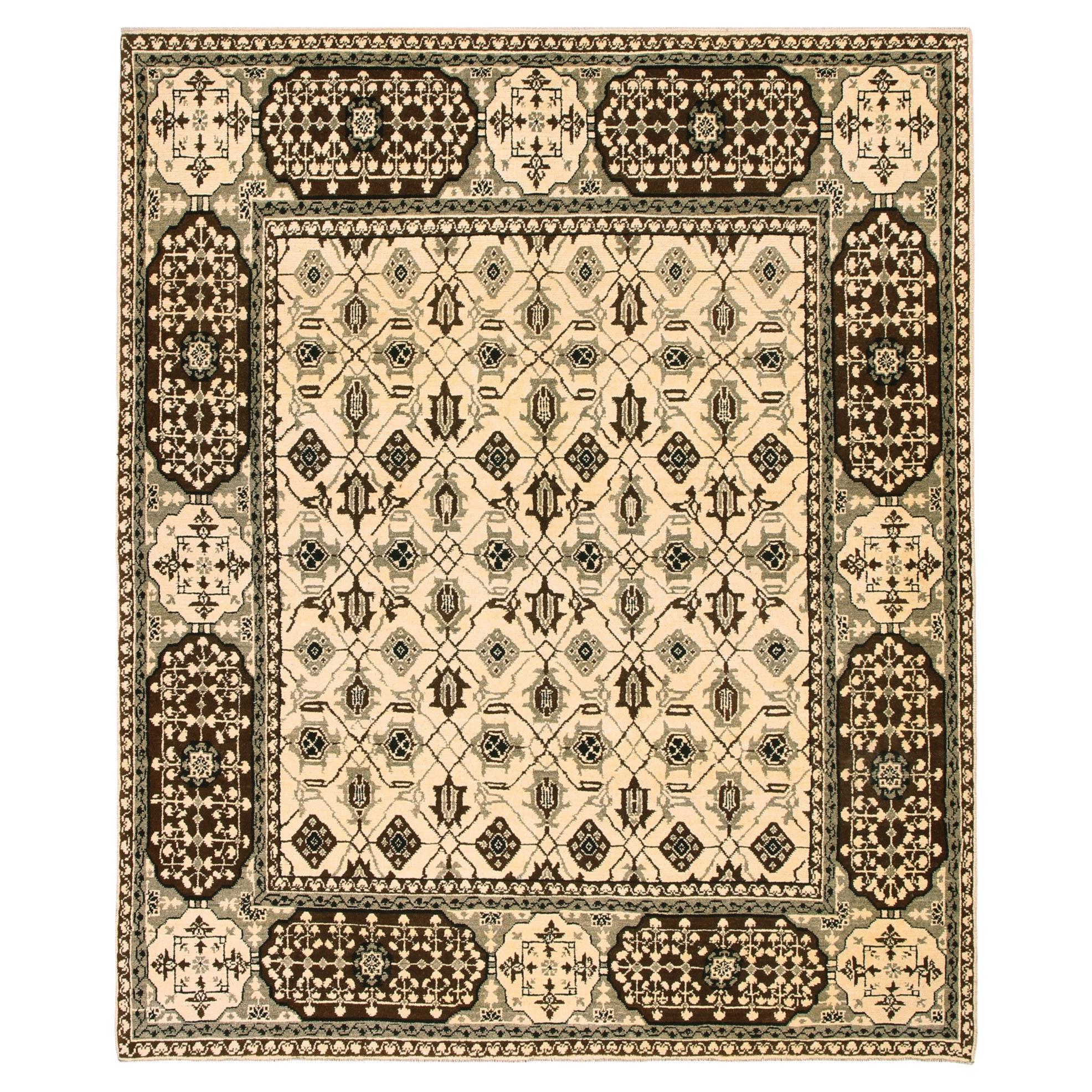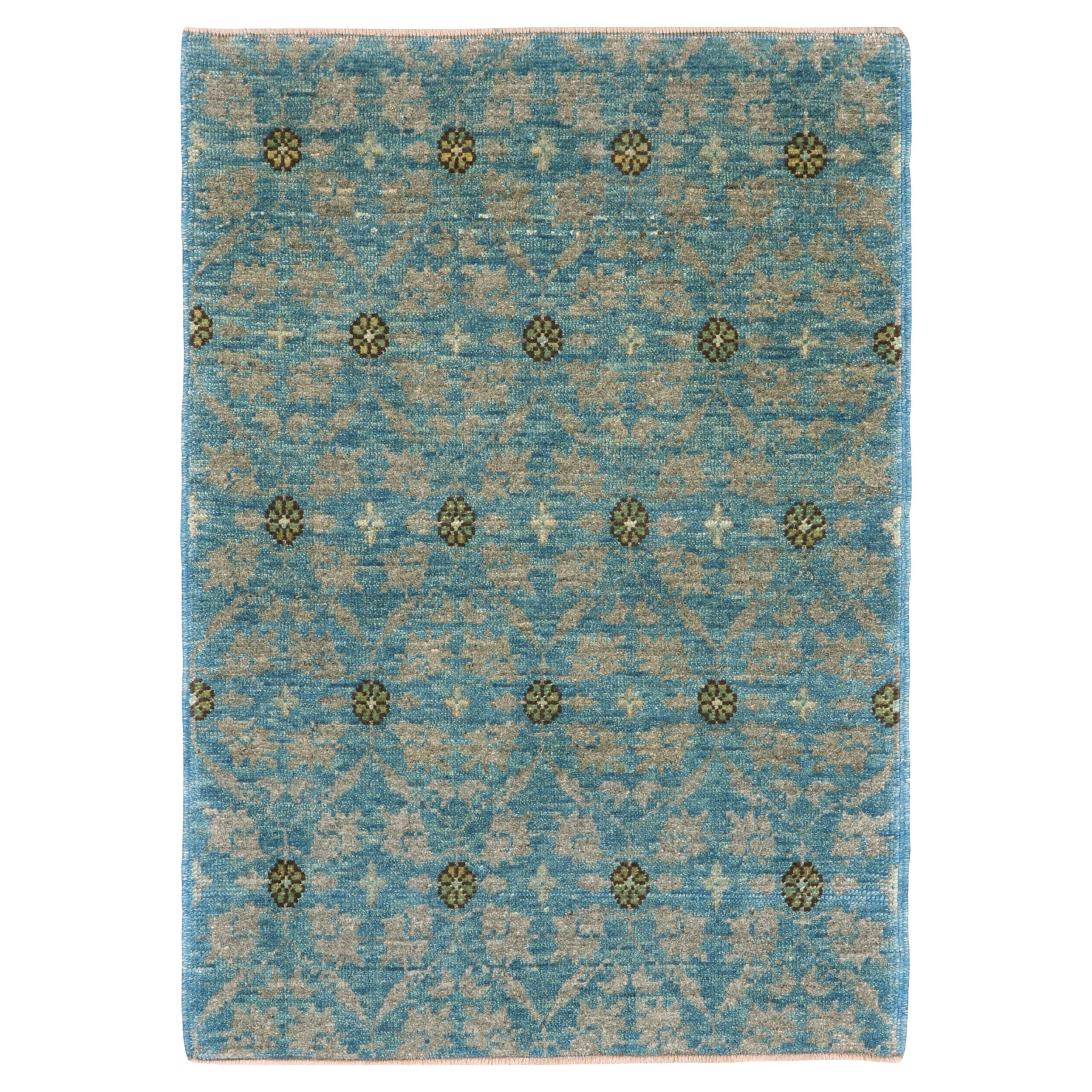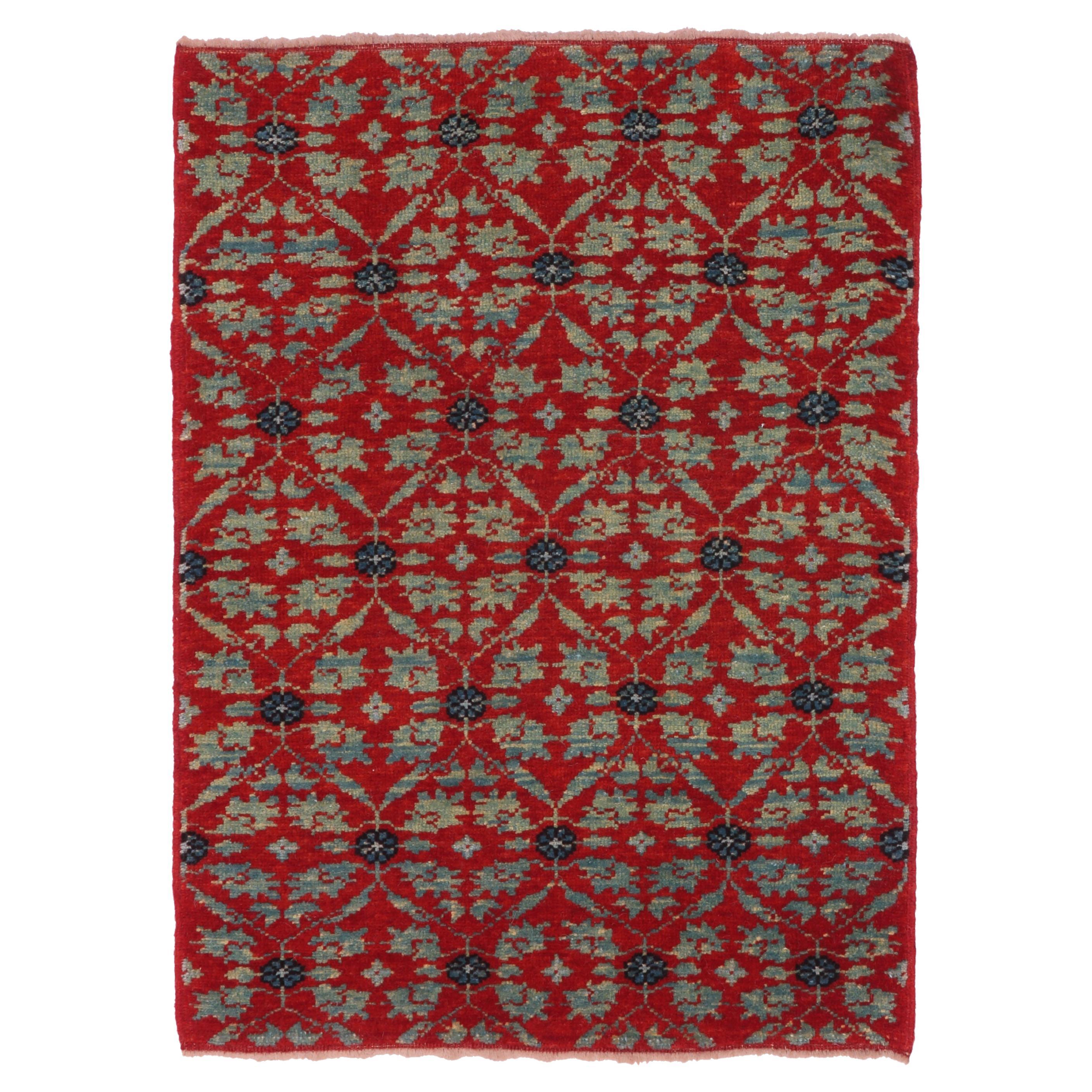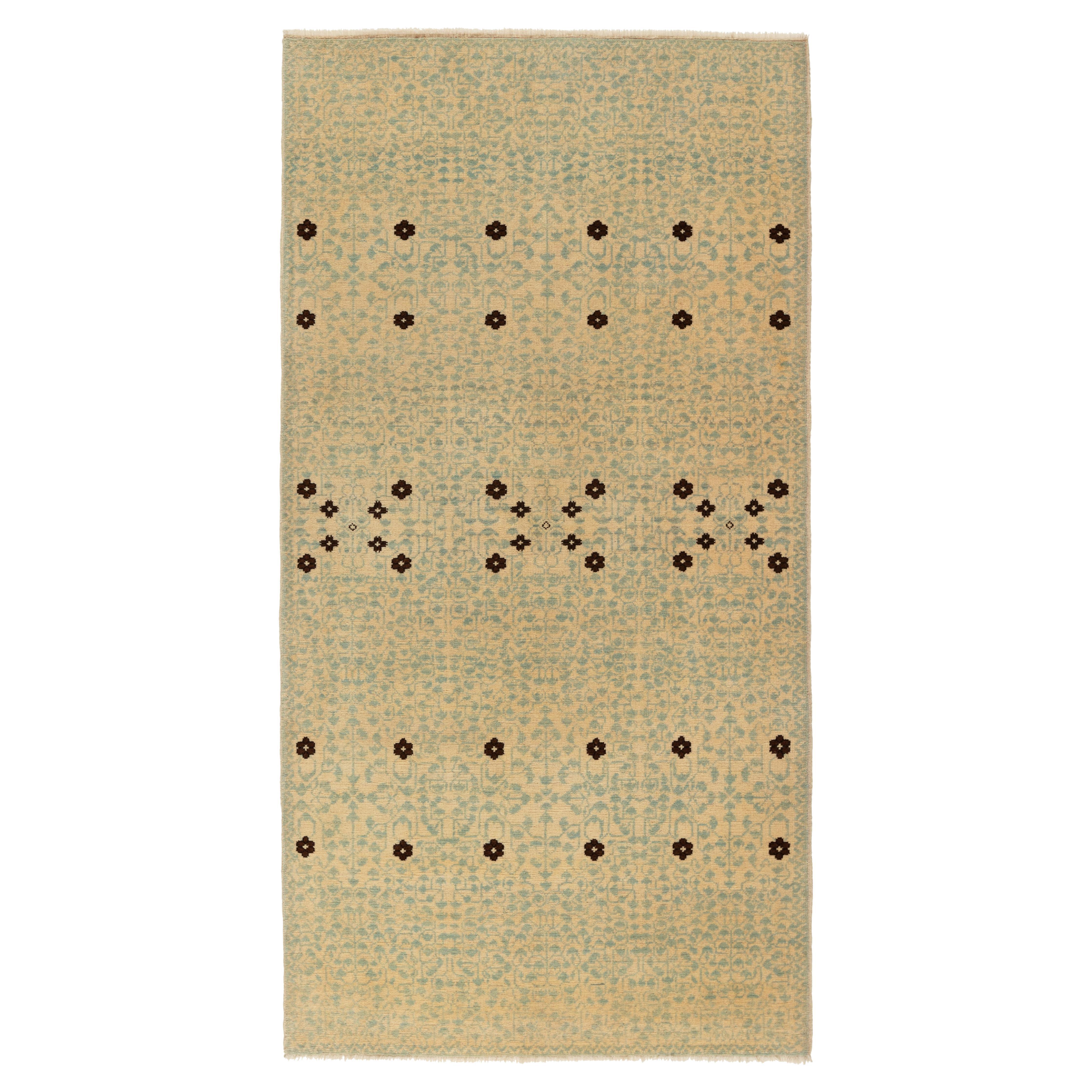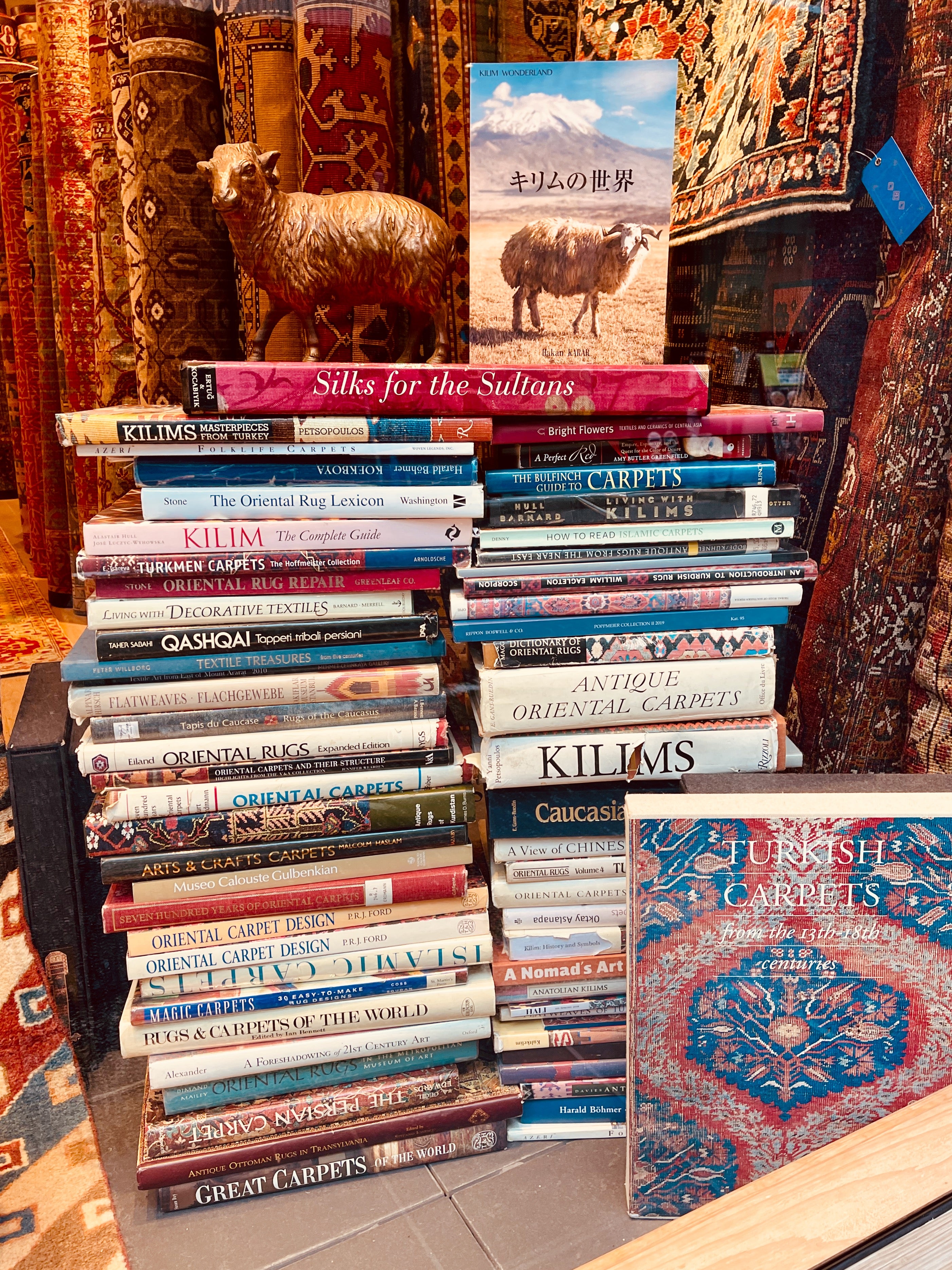Items Similar to Ararat Rugs Mamluk Carpet with Lattice Design, Natural Sheep Wool Colors No Dye
Video Loading
Want more images or videos?
Request additional images or videos from the seller
1 of 6
Ararat Rugs Mamluk Carpet with Lattice Design, Natural Sheep Wool Colors No Dye
About the Item
The source carpet comes from the Mercer Collection Sotheby’s 2000 (catalog cover). This Mamluk-Cairene carpet is known, curiously featuring some type of lattice was designed in the early 16th-century rug by Mamluk Sultane of Cairo, Egypt. This piece from the Bavarian National Museum in Munich is the most interesting, and well-qualified for a court appearance with its deployment of the Persian split-leaf arabesque placed daringly at the corners of the lattice. It has a sprightly, rhythmic elegance lacking in the other examples, such as the carpets in Berlin, Textile Museum, and the Mercer piece sold at Sotheby’s in 2000. Perhaps the starting point for this design venture was an Iranian model now lost to us. Only a similar type of Textile Museum carpet features the tulip-and-pineapple border usually reserved for medallion carpets, and the lattice design forms the accompanying background, incongruously, for a standard Mamluk medallion.
Attempting to read early carpets produced in workshops in Cairo provides an entirely different set of challenges. Cairene carpets, distinguished by their limited color palette, symmetrical knotting, and unusual construction of S-spun wool (Z-spun wool being the norm almost everywhere in the Islamic world), underwent a sudden change in design sometime after the Ottoman Turks conquered the Mamluk empire in 1517. The Simonetti Carpet was probably woven after the conquest but exhibits the “old” 15th century style of the Mamluks. Long and narrow, it was woven on a standard-sized Egyptian roller-beam loom, capable of producing carpets of varying lengths. It consists of five major focal areas of design in an A-B-C-B-A pattern, meaning the first and fifth and the second and fourth areas are paired, while the middle is unique. We can easily term these five focal areas medallions, but they are geometric in both layout and detail, and their style (as opposed to the actual date of the weaving) predates the carpet design revolution that gave rise to the medallion format. We can surmise that the designs and colors of Mamluk carpets, with their unusual combination of insect-derived red, blue, green, and sometimes yellow, with virtually no undyed white at all, constitute an effort to create a recognizable brand in the early modern market, especially in Europe, where Mamluk carpets such as this, with their subtle coloration, incredibly detailed design, and mosaic-like layout of small and intricately patterned geometric motifs, constituted an appealing alternative to the more coarsely woven and brightly colored carpets from Anatolia, such as Ushak medallion carpets. While the weaving of carpets in the traditional geometric Mamluk designs continued well into the 17th century, sometime around the Mid-16th Century, Cairene weavers began to create an entirely new kind of carpet, using their traditional Mamluk materials, technique, and coloration but reflecting the latest styles then being created at the court of the Ottoman sultans in Istanbul. The design of the rug is interpreted by our designers, and soft colors are used for this rug.
Color summary: 5 colors in total; (No dye, natural colors from Akkaraman Sheeps)
Rare Grey 105 (only specially washed)
Burnt Coffee 102 (only specially washed)
Bamboo Beige 99 (only specially washed)
Natural Wool Color 320 (Specially Washed)
Natural Wool Color 37 (Specially Washed).
Group: Islamic Rugs Family
Area: Mamluk
Material of Pile: Natural Dyed Hand-spun Wool
Material Warp / Weft: Wool on Wool
Structure: Symmetrical knot on depressed warp inclining to the right
Knots Density: 39x39
Production Place: Southeastern Anatolia – Diyarbakir - Yeniköy
Stock Location: Tokyo.
Size (EU): 151 X 217cm
Size (US): 4'11" X 7'1"
Area (EU): 3.3m²
Area (US): 35.3ft².
- Creator:Ararat Rugs (Manufacturer)
- Dimensions:Width: 59.45 in (151 cm)Length: 85.44 in (217 cm)
- Style:Revival (In the Style Of)
- Materials and Techniques:
- Place of Origin:
- Period:
- Date of Manufacture:2022
- Production Type:New & Custom(One of a Kind)
- Estimated Production Time:Available Now
- Condition:
- Seller Location:Tokyo, JP
- Reference Number:1stDibs: LU8206232799452
ARARAT RUGS
We know and believe that the geography we come from, our past, and our lifestyle are the most important bond between us to carry the oriental carpet art and culture to the next generations along with our core values in our ongoing growth journey.
We are aware that the way to achieve this goal and carry this priceless art and culture to the future depends on a lot of work with all our people every day while adhering to our core values.
For us, art is meaningful in the sense that it brings together various cultures around the world. It is an honor for us that oriental carpet art and culture have been instrumental in this for centuries and that we are a part of this business.
We are tirelessly keeping an eye on auction house information around the world about carpets. New York's Metropolitan, London's Victoria & Albert Museums, and other famous art museums, as well as small specialized museums that house private collections, and books about oriental carpets to collect information on outstanding carpet designs and patterns from around the world. It's our Self-improving and Self-developing culture.
As Turkish Culture of Hospitality, the Kurdish Culture of Generosity, and as Japanese Culture of Business Punctuality; are the most important values that this multicultural background has taught and bequeathed to us. It is essential and valuable for us that you feel this feeling not only by looking at our oriental carpets but from the moment you contact us.
About the Seller
5.0
Gold Seller
These expertly vetted sellers are highly rated and consistently exceed customer expectations.
Established in 1970
1stDibs seller since 2023
12 sales on 1stDibs
Typical response time: 1 hour
- ShippingRetrieving quote...Ships From: Tokyo, Japan
- Return PolicyA return for this item may be initiated within 7 days of delivery.
More From This SellerView All
- Ararat Rugs Mamluk Carpet with Lattice Design, Natural Sheep Wool Colors No DyeBy Ararat RugsLocated in Tokyo, JPThe source of carpet comes from the Mercer Collection Sotheby’s 2000 (catalog cover). This Mamluk-Cairene carpet is known, curiously featuring some type ...Category
21st Century and Contemporary Turkish Revival Turkish Rugs
MaterialsWool, Natural Fiber, Organic Material
- Ararat Rugs Mamluk Wagireh Rug with Flower Lattice Design Natural Dyed CarpetBy Ararat RugsLocated in Tokyo, JPThe source of carpet comes from the book Völker, Angela, Die orientalischen Knüpfteppiche das MAK, Vienna: Böhlau, 2001: 42–5. This rug with the central star was designed in the early 16th-century rug by Mamluk Sultane of Cairo, Egypt. It is exhibited at MAK – Museum of Applied Arts, Vienna Austria. The interpreted design is composed of a flower lattice pattern taken from a part of the MAK Museum’s rug...Category
21st Century and Contemporary Turkish Revival Turkish Rugs
MaterialsWool, Natural Fiber, Organic Material
- Ararat Rugs Mamluk Carpet with Lattice Design, Antique Revival Rug Natural DyedBy Ararat RugsLocated in Tokyo, JPThe source of carpet comes from the Mercer Collection Sotheby’s 2000 (catalog cover). This Mamluk-Cairene carpet is known, curiously featuring some type ...Category
21st Century and Contemporary Turkish Revival Turkish Rugs
MaterialsWool, Natural Fiber, Organic Material
- Ararat Rugs Mamluk Wagireh Rug with Flower Lattice Design Natural Dyed CarpetBy Ararat RugsLocated in Tokyo, JPThe source of carpet comes from the book Völker, Angela, Die orientalischen Knüpfteppiche das MAK, Vienna: Böhlau, 2001: 42–5. This rug with the central star was designed in the early 16th century rug by Mamluk Sultane of Cairo, Egypt. It is exhibited at MAK – Museum of Applied Arts, Vienna Austria. The interpreted design is composed of a flower lattice pattern taken from a part of the MAK Museum’s rug...Category
21st Century and Contemporary Turkish Revival Turkish Rugs
MaterialsWool, Natural Fiber, Organic Material
- Ararat Rugs Mamluk Wagireh Rug Leaf Lattice Design, Revival Carpet Natural DyedBy Ararat RugsLocated in Tokyo, JPThe source of carpet comes from the book Völker, Angela, Die orientalischen Knüpfteppiche das MAK, Vienna: Böhlau, 2001: 42–5. That rug with the central star was designed in the early 16th Century rug by Mamluk Sultane of Cairo, Egypt. It is exhibited at MAK – Museum of Applied Arts, Vienna Austria. The interpreted design is composed of a leaf lattice pattern taken from the border of the MAK Museum’s rug...Category
21st Century and Contemporary Turkish Revival Turkish Rugs
MaterialsWool, Natural Fiber, Organic Material
- Ararat Collection, Mamluk Wagireh Rug with Flower Lattice Natural Dyed CarpetBy Ararat RugsLocated in Tokyo, JPThe source of carpet comes from the book Völker, Angela, Die orientalischen Knüpfteppiche das MAK, Vienna: Böhlau, 2001: 42–5. This rug with the central star was designed in the early 16th-century rug by Mamluk Sultane of Cairo, Egypt. It is exhibited at MAK – Museum of Applied Arts, Vienna Austria. The interpreted design is composed of a flower lattice pattern taken from a part of the MAK Museum’s rug...Category
21st Century and Contemporary Turkish Revival Turkish Rugs
MaterialsWool, Natural Fiber, Organic Material
You May Also Like
- 6.2x7.2 Ft Contemporary Turkish Rug. 100% Wool, Natural Dyes, Modern CarpetLocated in Philadelphia, PAA hand-knotted contemporary Turkish rug featuring a geometric design. This colorful modern rug has even medium wool pile on wool foundation. It is made of premium hand-spun sheep ...Category
2010s Turkish Tribal Turkish Rugs
MaterialsCotton
- Natural Dye Mamluk Design Rug Fable CollectionBy Mehraban RugsLocated in WEST HOLLYWOOD, CAA majestic Mamluk Design rug from our collection features grandiose medallions and motifs. Borders are well-coordinated with intricate patterns over a goldfield. Perfect for your int...Category
21st Century and Contemporary Afghan Central Asian Rugs
MaterialsWool
- Vintage Mamluk Rug with All-Over Ottoman DesignBy Keivan Woven ArtsLocated in Atlanta, GALarge Vintage Mamluk Rug, rug WL-266930, country of origin / type: Turkey / Mamluk, circa Late-20th Century. Measures: 8'11 x 11'9. Finely Handwoven i...Category
Late 20th Century Turkish Oushak Turkish Rugs
MaterialsWool
- Vintage Turkish Oushak Rug with Lattice Blossom Design in Camel and Gray ColorsLocated in Atlanta, GAVintage Turkish Oushak rug with Lattice blossom design in camel and gray colors, rug en-141301, country of origin / type: Turkey / Oushak, circa 1940 Set on a camel-colored field ...Category
Vintage 1940s Turkish Oushak Turkish Rugs
MaterialsWool
- 10x12.4 Ft Midcentury One-of-a-Kind Oushak Wool Rug in Soft Colors, Natural DyesLocated in Philadelphia, PAA vintage handmade Central Anatolian rug with a bold geometric design and beautiful soft colors. Finely hand knotted with even medium wool pile on wool foundation. Excellent conditio...Category
Mid-20th Century Turkish Oushak Turkish Rugs
MaterialsWool
- Natural Dye Mamluk Revival RugBy Mehraban RugsLocated in WEST HOLLYWOOD, CAA classic revival of Mamluk rug is phenomenal with traditional style. An oversized rug that has neutral colors of sepia. Medallions and blooming ornaments are symmetrically aligned a...Category
21st Century and Contemporary Afghan Central Asian Rugs
MaterialsWool
